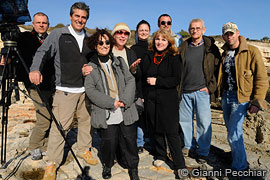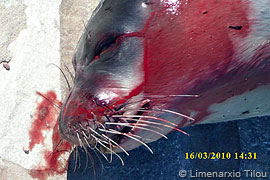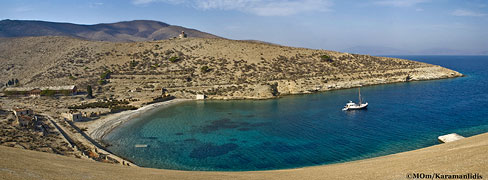


 |
||
 |
||
 |
||
Vol. 13 (1): June 2010 |
||
Croatia / Greece / Mauritania & Western Sahara / Turkey
Croatia
|
 |
 |
|
|
The seal nears observers on 27 February 2010. |
Teamwork: Italian and Croatian colleagues at Cape Kamenjak. |
 |
|
|
Shot dead on Tilos. |
Fifteen dead monk seals have been reported to MOm’s Rescue and Information Network (RINT) so far since January 2010. The cases involve seals of all age groups (6 adults, 3 sub-adults, 4 weaners, 1 pup and 1 of unknown age group) and both sexes.
The cases also originate from different areas of Greece, namely 5 in the Dodecanese (Eastern Aegean), 3 in the Northern Aegean and 6 in the Cyclades. Of these cases, 3 animals were shot to death, while 2 more reveal signs of violent death.
Although it is still too early to draw firm conclusions, the number of deaths is already high and the number of deliberate killings even more alarming.
MOm has already brought these concerns to the attention of the Minister of Environment, Tina Birbili, and urgently requested the implementation of the Action Plan for the Mitigation of the Negative Effects of Monk Seal-Fisheries Interactions in Greece, published last year, following a 3-year research project funded by the EU Life/Nature programme. – Marianna Psaradellis, MOm.
MOm. 2009. Action Plan for the mitigation of the negative effects of monk seal ‐ fisheries interactions in Greece, Summary Report. MOm, WWF Greece, Fisheries Research Institute, 2009: 1-11. [PDF  2.9 MB]
2.9 MB]
Following the opening-up of a restricted naval zone at the island of Gyaros in the central Aegean, MOm undertook a research effort to assess the status of the Mediterranean monk seal in the area.

Gyaros.
Data collected quickly led us to the conclusion that this newly discovered breeding colony is of utmost importance for the conservation of the species and that it needs urgent protection. Since Gyaros was not at that time part of the NATURA 2000 network, it was feared that its new status, free of military access restrictions, would spell trouble for the monk seal colony.
MOm presented these findings and scientific evidence to the Greek authorities, with an appeal that the island be incorporated in the Natura 2000 network. The Ministry of Environment subsequently agreed, and has recently taken the necessary legal steps to achieve that objective. This should be considered an important first step for the protection of the species on Gyaros before detailed protected area management plans can be designed and implemented. – Panos Dendrinos, MOm.
Dendrinos, P., A.A. Karamanlidis, S. Kotomatas, V. Paravas and S. Adamantopoulou. 2008. Report of a new Mediterranean monk seal (Monachus monachus) breeding colony in the Aegean Sea, Greece. Aquatic Mammals 34(3): 355-361. [Abstract]
EndQuoteMore emotion, less science Croatian Doctor Sasa Nesic from Pula recorded the first sighting of a Mediterranean Monk Seal in 20 years on 24 January. Nesic saw the "beauty Glaxiana," as he named his Mediterranean Monk Seal, at the place where he usually goes to relax and play the guitar. He recorded more than 20 minutes of Glaxiana, but their "meeting" lasted for an hour and a half. In his interview with the Croatian Times, he said: "I would love to talk more about emotion and less about scientific facts. My friend told me the appearance of the Mediterranean Monk Seal in front of me in my favourite place symbolised love, and I find that beautiful. I have proved the seal exists in the Adriatic Sea. She enchanted me totally, like sirens in fairy tales." Nesic added he would love it if his experience was educational for the younger generation and make it more aware of the value of one of the most-endangered mammals in the world.
|
Mediterranean News continues with Mauritania & Western Sahara and Turkey...
Copyright © 2010 The Monachus Guardian. All Rights Reserved |